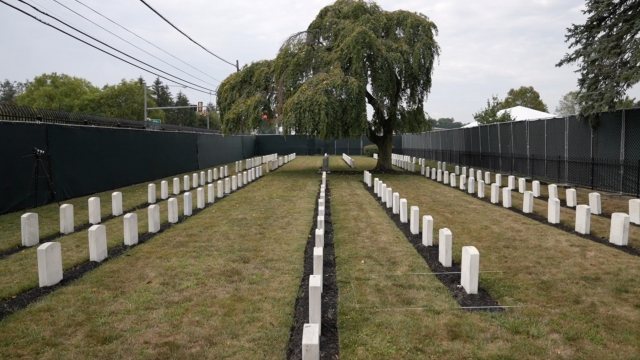White headstones sit tucked away in a corner of the former site of the Carlisle Indian Industrial School. Five of them are now marked with white string — a sign of what's about to happen here.
"We're returning five children to five separate tribes," said Renea Yates, director of the Office of Army Cemeteries, which is in charge of the disinterment and return of the Native American children buried there.
Now the site of the U.S. Army Barracks in Carlisle, Pennsylvania, the Carlisle Indian Industrial School operated between 1879 and 1918, forcibly bringing more than 10,000 Native American children there to be assimilated into White culture.
The school was one of the first of its kind and became a model for the hundreds of other Native American Boarding Schools that would soon follow around the country.
Not all of the students survived the experience: At least 200 children died at the Carlisle school alone.
The Army took over the property after the school closed and moved the cemetery.
"It was moved in 1927, and all those graves were relocated," Yates said. "There were 186 graves relocated and there are 14 unknowns."
SEE MORE: Survivors of Florida boys' school recount past and fight for change
Several years ago, a team of forensic archaeologists and anthropologists began working to return some of the buried children to their families and tribes — 28, so far — with the disinterment of five more children set for September.
"We operate on a request basis," Yates said. "So, if the family and tribe request the return, we work with them to conduct the return."
According to the Federal Indian Boarding School Initiative — an ongoing federal investigation into the historic boarding school system — from the 1800s through the 1970s, there were more than 400 taxpayer-funded, sometimes church-affiliated, Native American boarding schools.
Exact numbers of how many students attended those schools are not clear, but estimates range in the hundreds of thousands. Many of them experienced physical, sexual and emotional abuse at the schools.
"This was something that the federal government sanctioned, funded, operated and also supported other institutions as a project of colonization, as a project of Western expansion," said Dr. Samuel Torres, deputy CEO of the nonprofit National Native American Boarding School Healing Coalition.
The organization is working with the federal government on the investigation it launched in 2021, which is looking to understand exactly what happened to the students.
SEE MORE: Nonprofit works to protect Black and Native American burial sites
The coalition just issued a new report with an interactive map that shows an even higher number of schools existed than previously believed: more than 500.
"We emerged as a grassroots effort from Native organizers, tribal leaders, boarding school survivors and descendants who fundamentally wanted to come together to produce a similar type of investigation — a commission, really — that was first similarly seen in Canada with the Truth and Reconciliation Commission," Torres said.
Currently in Congress, Senate bill 1723 would establish a similar commission in the United States, but so far, a companion bill has not been filed in the House.
"In order to heal, we actually need to know what we're healing from," Torres said. "A commission process will not be the end-all answer to how do we heal, but it will certainly contribute to how we lay a blueprint for what those next steps are."
Steps that are necessary, they say, because time is of the essence.
Trending stories at Scrippsnews.com





